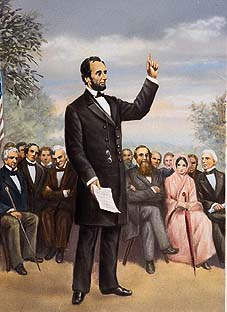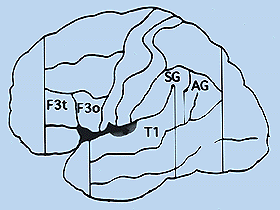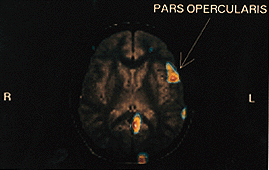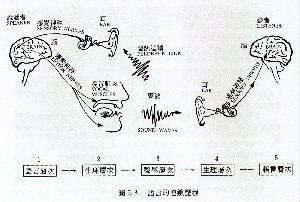BY DAVID CAPLAN, M.D., PH.D.
![]() anguage
is one of the pillars of the human intellect. It is the principal means whereby
individuals formulate thoughts and convey them to others. It plays a role in
analyzing the world, in reasoning, solving problems, and planning actions. It
allows us to convey memories of the past and beliefs about the future, to engage
others about events that have not taken place, and to express the relations
between events.
anguage
is one of the pillars of the human intellect. It is the principal means whereby
individuals formulate thoughts and convey them to others. It plays a role in
analyzing the world, in reasoning, solving problems, and planning actions. It
allows us to convey memories of the past and beliefs about the future, to engage
others about events that have not taken place, and to express the relations
between events.
 Language
is an indispensable part of human culture, without which jurisprudence,
commerce, science and other human endeavors could not exist in the forms we know
them. It is an object of beauty in its own right. A combination of semantic and
artistic force can make writings such as Second Isaiah, the Gettysburg Address,
or Shakespeare's sonnets, the definitive statements of spirituality,
jurisprudence, or personal love for a culture or an individual.
Language
is an indispensable part of human culture, without which jurisprudence,
commerce, science and other human endeavors could not exist in the forms we know
them. It is an object of beauty in its own right. A combination of semantic and
artistic force can make writings such as Second Isaiah, the Gettysburg Address,
or Shakespeare's sonnets, the definitive statements of spirituality,
jurisprudence, or personal love for a culture or an individual.
Language is vital to individual success, and diseases affecting language can cripple a person in his or her family or social group. Ongoing research is making progress in understanding language, its neural basis, and how to successfully intervene in the course of language disorders.
Lincoln gives Gettysburg Address, November 19, 1863. Undated illustration, artist unknown. (The Bettmann Archive.)
The language code
Modern linguistics has taught us that, in its essence, language is a special
kind of code. A "standard" code consists of a set of symbols that can
be connected to the words and phrases in a language. When we crack a code, we
understand an encoded message because we understand the language that we have
translated the code into. Natural language is
a different sort of code, because its forms are related to meaning directly.
The forms of language are simple words, sentences, intonation, and other "representations." Words refer to objects, actions, properties and logical connections. Sentences relate words to each other to depict events and states of affairs in the conversation or whether a sentence is a statement or a question. Language is a complex code because all these types of representations interact to determine the meaning of each sentence in each context.
Processing language
Language processors activate these linguistic representations in speaking,
understanding, reading and writing, in a remarkably fast and accurate way. For
instance, when we speak, we select words in accordance with what we think our
listener will understand. We activate the sounds for each word. We construct a
syntactic structure to relate the words to each other, and an intonational
contour to convey the syntax.
All this information is translated into movements of the mouth, jaw, tongue, palate, larynx and other articulators that are regulated on a millisecond-by-millisecond basis, so that we produce about three words per second or one sound every tenth of a second on average. Yet we only make about one sound error per million sounds and one word error per million words.
Watching the brain speak and listen
Scientists have tried for over a century to understand how the brain learns,
stores, and processes language. The task is difficult because there are no
animals who have symbol systems as rich as language. Therefore, for a long time,
information about how the brain processed language could only come from the
study of the effects on language of neurological disease in humans. In the past
decade, exciting new techniques have allowed us to picture the normal brain at
work processing language. What used to take decades to learn, as scientists
waited for the opportunity to examine the brains of patients at post-mortem, can
now be approached in months using positron emission tomography, special analyses
of electroencephalograms, functional magnetic resonance imaging,
magnetoencephalography, and other tools.
Left-brain/Right-brain
As is true for every other functional ability, parts of the brain specialize in
language. The brain has two roughly identical halves -- the left and the right
hemispheres. We now know that there are small differences in the sizes of some
regions in the two hemispheres. These differences may form the basis for the
first major brain specialization for language -- lateralization of language to
the left hemisphere.
In about 98 percent of right-handers, the left hemisphere accomplishes most language processing functions. In non-right handers (which include left-handed and ambidextrous people), language functions are far more likely to involve the right hemisphere. There is some evidence that lateralization differs in males and females.
There is also evidence that the non-dominant hemisphere is primarily involved in functions that are just one step beyond the essential language functions of relating form to literal meaning. These include determining the emotional state of a speaker from his or her tone of voice, and appreciating humor and metaphor.

Legend:
F3t = pars triangularis
F3o = pars opercularis
SG = supramarginal gyrus
AG = angular gyru
TI = first temporal gyrus
A surface map, side view, of regions in the left hemisphere's "language zone" surrounding the sylvian fissure (darkened area lower left). (Courtesy of Dr. Caplan.)
Within the dominant hemisphere
The second major brain specialization for language is within the left
hemisphere. Only a relatively small part of the cortex is responsible for
language processing. This region lies around the sylvian fissure (the deep fold
in the brain lying roughly parallel to and above a line from the outside corner
of the eye to the middle of the ear), and consists of advanced association
cortex. This area appears to be responsible for sign language as well as spoken
language. The way language is used exerts some effect however: Written language
probably involves areas nearer the visual cortex, and sign language may recruit
areas close to those related to the ability to locate objects in space.
Can we be more specific about exactly where in this language region particular language operations are carried out? Where do we activate the sounds of specific words, or compute the meaning of a sentence? The jury is out on this question. Since the earliest investigations into the topic, some scientists have thought that the language region works more or less as a unit, while others have sworn by the idea that individual language operators are localized in specific parts of this region.
Our own data may indicate why this controversy has endured so long. We studied different types of language impairments. One was patients' abilities to construct syntactic structures -- the ability to structure the sentence The dog that chased the cat ate the cheese so that, despite the sequence of words the cat ate the cheese, the dog and not the cat is understood as the animal doing the eating. We found that damage to any part of the language zone can affect the ability to assign syntactic structure. There was even evidence for a mild impairment in syntactic processing after strokes in the right hemisphere, though the effect was much less than after left hemisphere damage
This suggests that there is some truth to the idea that the entire language zone is involved in syntactic processing. However, when we studied the areas of the brain that increased their blood flow while normal subjects read syntactically complex sentences, only a small part of this area increased its metabolic activity. This suggests that there is some specialization within the language area that is involved in syntactic processing.

Positron emission tomography captures an increase in blood flow to the pars opercularis (largest bright spot), a small area of the language zone that may be specialized for processing sentences with complex syntax. (PET scan courtesy of Dr. Caplan.)
The picture may be even more complicated, because what is true for syntactic
processing may not be true for other language operations. When we studied
deficits in the ability to convert the sound waves that hit the ear into speech
sounds, we found that strokes that disrupt this process tend to occupy a region
of cortex quite close to the primary auditory cortex. This was quite different
from the pattern seen regarding disturbances of syntactic processing, where
strokes in many areas impaired this function.
The differences in the studies may be because larger brain regions are involved in more abstract operations -- like computing syntax -- while smaller regions that are nearer to sensory cortex are involved in operations that are closer to elementary sensory processing. Thus, putting together the pieces of the puzzle of the how the brain is organized to support language may be a very complex task. The application of new imaging techniques will move research in this area along at the most rapid pace ever known.
Starting the engine and driving the system
The language system is connected to other intellectual and motor systems. People
use language to inform others, to ask for information, to get things done, etc.
The mechanisms that trigger language use require motivation and arousal.
Functional neuroimaging studies have provided strong evidence that areas such as the frontal lobes and structures deep in the brain, such as the cingulate gyrus, become active during many language tasks.
Perhaps these structures are related to the level of arousal needed to activate language processors.
Once language use is initiated, it must be regulated in time and monitored. The relevant timing mechanisms may lie in the cerebellum and in subcortical gray matter, which recently have been found to be active during many language functions and to result in language impairments when lesioned.
Diseases affecting language
Although the deprivation of any function is onerous, diseases that affect
cognition are devastating to humans in a particular way. Not being able to
communicate thoughts efficiently can cut a person off from his or her livelihood
and family and have immense effects on emotional state and social position.
Language can be impaired by sudden events such as stroke or head injuries,
insidiously progressive conditions such as Alzheimer's or Parkinson's Disease,
or developmental disorders as happens in dyslexia.
We now are able to make highly specific diagnoses of what language processors are affected in a particular language disorder, and recent work has begun to demonstrate that targeting these specific impairments can improve language functioning. As we know more about the brain mechanisms involved, medical therapies such as those that improve attention will also become more tailored to remediation of particular language disorders. The future holds much promise for applying our rapidly-accruing knowledge regarding the neural basis of language to improving the quality of life of language-impaired individuals. *
Dr. Caplan is Associate Neurologist at Massachusetts General Hospital.
The Domain of Study
Many linguistics departments offer a course entitled 'Language and Brain' or 'Language and Mind.' Such a course examines the relationship between linguistic theories and actual language use by children and adults. Findings are presented from research on a variety of topics, including the course of language development, language production and understanding, and the nature of language breakdown due to brain injury. These topics provide examples of what is currently known about language and the mind, and they offer insights into the central issues in this area of linguistic research.
Language is a significant part of what makes us human, along with other cognitive skills such as mathematical and spatial reasoning, musical and drawing ability, the capacity to form social relationships, and the like. As with these other cognitive skills, linguistic behavior is open to investigation using the familiar tools of observation and experimentation.
It is wrong, however, to exaggerate the similarity between language and other cognitive skills, because language stands apart in several ways. For one thing, the use of language is universal--all normally developing children learn to speak at least one language, and many learn more than one. By contrast, not everyone becomes proficient at complex mathematical reasoning, few people learn to paint well, and many people cannot carry a tune. Because everyone is capable of learning to speak and understand language, it may seem to be simple. But just the opposite is true--language is one of the most complex of all human cognitive abilities.
The Language Instinct
Even outside the laboratory, one can make many interesting observations that one can make about the course of language development. Many of the most complex aspects of language are mastered by three- and four-year-old children. It is astonishing for most parents to watch the process unfold. What many parents don't realize is that all children follow roughly the same path in language development. And all children reach essentially many of the same conclusions about language, despite differences in experience. All preschool children, for example, have mastered several complex aspects of the syntax and semantics of the language they are learning. This suggests that certain aspects of syntax and semantics are not taught to children. Further underscoring this conclusion is the finding, from experimental studies with children, that knowledge about some aspects of syntax and semantics sometimes develops in the absence of corresponding evidence from the environment.
To explain this remarkable collection of facts about language development, linguists have attempted to formulate a theory of linguistic principles that apply to all natural languages (as opposed to artificial languages, such as programming languages). These principles, known as linguistic universals, offer insight into the acquisition scenario set out before us: why language is universal, why it is mastered so rapidly, why there are often only loose or incomplete connections between linguistic knowledge and experience. These features of development follow from a single premise--that linguistic universals are part of a human 'instinct' to learn language, i.e., part of a biological blueprint for language development.
There is another way in which knowledge of language and real-world experience are kept apart in the minds of children; they do not always base their understanding of language on what they have come to know from experience. For example, children do not combine the words of the sentence 'Mice chase cats' in a way that conforms with their experience; if they did, they would understand it to mean that cats chase mice, not the reverse. In other words, children are able to tell when sentences are false, as well as when they are true. This means that children use their knowledge of language structure in comprehending sentences, even if it means ignoring their wishes and the beliefs they have formed about the world around them.
Modularity
Research on adult language understanding is also concerned with the architecture of the mind and with the possibility that linguistic knowledge and belief-systems reside in separate 'modules'. To investigate the issue of modularity, studies of adult language understanding ask when different sources of information are used in processing sentences that have more than one possible interpretation. It is in the nature of language that many sentences are ambiguous. Yet, ordinarily, by the time a person reaches the end of an ambiguous sentence, only a single interpretation remains, the one that is consistent with the conversational context. In the absence of any context, e.g. in a laboratory setting, the interpretation that survives is often the one that best conforms with a person's general knowledge of the world.
Adopting a modular conception of the mind, some researchers contend that the preference for one interpretation over its competitors is initially decided on linguistic grounds (syntactic and semantic structure); real-world knowledge comes into play only later, on this view. The availability of different sources of information is difficult to determine, however, because the resolution of ambiguity takes place as a sentence is being read or heard, rather than after all the words have been taken in. In order to establish the time-course of various linguistic and nonlinguistic operations involved in language understanding, sentence processing is often measured in real time, by recording the movements of the eyes in reading, for example. The jury is still out on the question of the modularity of mind in language processing, but there are some suggestive research findings, and few researchers in the area would deny the contribution of linguistic knowledge in the process.
Another source of evidence bearing on the modularity hypothesis comes from studies of language breakdown. Language loss, or aphasia, is not an all-or-nothing affair; when a particular area of the brain is affected, the result is a complex pattern of retention and loss, often involving both language production and comprehension. The complex of symptons can be strikingly similar for different people with the same affected area of the brain. Research in aphasia asks: Which aspects of linguistic knowledge are lost and which are spared? The fact that language loss is not always associated with a corresponding loss of pragmatic knowledge supports the modularity hypothesis, bringing the findings of research on aphasia in line with those from the study of child and adult language understanding..
語言認知與表達的歷程:語言層次→生理層次→聲學層次→生理層次→語言層次

http://home.kimo.com.tw/lennelwang/3main.html#2
http://www.cs.colorado.edu/~martin/slp.html
http://www.ccunix.ccu.edu.tw:8000/~lngmyers/biolxresources.html
Department of Artificial Intelligence
Natural Language Processing Group
http://www.dai.ed.ac.uk/groups/nlp/NLP_home_page.html
Columbia Natural Language Processing Group
http://www.cs.columbia.edu/nlp/
The Natural Language Processing Laboratory